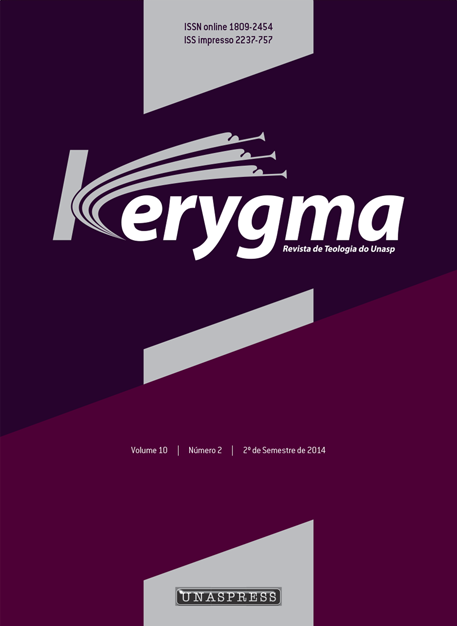Abstract
O presente artigo trata da validade da vara como método de disciplina à luz de Provérbios 13:24. Faz uma análise dos principais termos do verso e seu paralelismo específico, procurando estabelecer a relação sintática dos termos, estabelecendo a conexão do verso com o conceito bíblico da disciplina divina. Indica-se que a disciplina tem uma função redentora e que o uso da vara é uma realidade aceitável somente quando o objetivo é disciplinar para salvar. Conclui-se que o texto de Provérbios 13:24, de acordo com seu contexto, é um louvor à disciplina redentora, não meramente um método de castigo.
Palavras-Chave: Vara; Paralelismo; Disciplina; Provérbios; Redenção.
Abstract: This article deals with the rod validity as a method of discipline in light of Proverbs 13:24. We analyze the key terms of the verse and its specific parallelism, seeking to establish syntactic relation of terms, establishing the back of the connection to the biblical concept of divine discipline. Our study indicates that the discipline has a redemptive function and the use of the rod is an acceptable reality only when the objective is to discipline to save. We conclude that the text of Proverbs 13:24, according to its context, is a hymn to the redemptive discipline, not merely punishment method.
Key words: Rod; Parallelism; Discipline; Proverbs; Redemption.
References
BOTTERWEEK, J. G. (Ed.). Theological Dictionary of the Old Testament. Grand Rapids: Eerdmans Publishing Company, 1998. v. 9.
MAIORIA já deu, levou e é contra proibir palmadas. Folha de São Paulo, 2010. Disponível em: <http://bit.ly/1TgaisX>. Acesso em: 07 de maio 2012.
NALON, T. Dilma sanciona Lei da Palmada e veta obrigação de servidor relatar violência. Folha de São Paulo, 2014. Disponível em: <http://bit.ly/1nQi34k>. Acesso dia 11 set. 2014.
HARRIS, R. L. Dicionário Internacional de Teologia do Antigo Testamento. São Paulo: Vida Nova, 1998.
KIDNER, D. Provérbios: introdução e comentário. São Paulo: Mundo Cristão, 1986.
LASOR, W. S. Introdução ao Antigo Testamento. São Paulo: Vida Nova, 2002.
REID, G. W. (Ed.). Compreendendo as Escrituras: uma abordagem adventista. Engenheiro Coelho: Imprensa Universitária Adventista, 2007.
ROSÁRIO, M. Projeto de lei nº 2654 /2003, [s. d.]. Disponível em: http://bit.ly/1QwbnXy. Acesso em: 07 jun. 2012.
SCHOKEL, L. A. Dicionário Bíblico Hebraico-Português. São Paulo: Paulus. 1997.
SCHWANTES, M. Repetições e Paralelismos: observações em um debate hermenêutico, exemplificado em provérbios 10,1. Fragmentos de cultura Instituto de Filosofia e teologia Sociedade Goiânia de cultura universidade católica de Goiás, Goiânia, v. 15, n. 9, p. 1345-1474, 2005.
TAYLOR, J. W. The path to redemptive discipline. The Journal of Adventist Education, v. 73, n. 3, 2011. Disponível em: http://bit.ly/240Rl1p. Acesso em: 22 jun. 2012.
VIRKLER, H. Hermenêutica avançada: princípios e processos de interpretação bíblica. São Paulo: Vida Acadêmica, 2001.
WHITE, Ellen G. Orientação da Criança. Tatuí: Casa Publicadora Brasileira, 1996.
Authors who publish on Kerygma must agree to the following terms:
- Once accepted for publication, the copyright of articles is automatically transferred to Kerygma.
- All material used in the text that is copyrighted by third parties must be duly referenced.
- Authors must also retain the reproduction rights of images and tables in their material, if necessary.
- The authors guarantee that the submitted text is entirely their authorship and has not been submitted and/or published elsewhere.
- The opinions, ideas and concepts expressed in the texts are the sole responsibility of their authors and do not necessarily represent the opinion of Kerygma;
- The editors reserve the right to make textual adjustments and adapt to the publication's norms.
- Authors retain copyright and grant the journal the right of first publication, with the work simultaneously licensed under Creative Commons Attribution-NonCommercial 4.0 International, which allows sharing of the work with acknowledgment of authorship and initial publication in this journal. This license allows others to remix, adapt, and build upon your work non-commercially, as long as they give proper credit to you and their new works are not used for commercial purposes. However, users are not required to license those derivative works under the same terms.
- The authors agree with the free reproduction of their material by Kerygma, which may adapt, modify, condense, summarize, reduce, compile, expand, alter, mix with other content, include images, graphics, digital objects, infographics and hyperlinks, illustrate, diagram, divide, update, translate and carry out any other transformations, requiring the participation or express authorization of the authors.
- The authors agree that Kerygma can distribute the articles through cable, fiber optics, satellite, airwaves or any other system that allows access to the user at a specific time and place, either by free channels or by systems that import payment. Kerygma may also include work in a physical or virtual database, archiving in printed format, storing on a computer, in a cloud system, microfilming and other current forms of archiving or that may still be developed, with or without profit.
- Authors are permitted to enter into separate, additional agreements for the non-exclusive distribution of the published version of the work in this journal (e.g., publishing it in an institutional repository or as a book chapter), with acknowledgment in the new publication of its initial publication in this journal.
- Kerygma owns the rights to all works published by it. The full reproduction of these texts in other publications, for any other purpose, by any means, requires written authorization from the publisher. The same goes for partial reproductions, such as summary, abstract, portions with more than 500 words of the text, tables, figures, illustrations, etc.
- Authors are granted permission and encouraged to publish and distribute their work online (e.g., in institutional repositories or on their personal websites) at any point before or during the editorial process. This is because it can lead to productive alterations and increase the impact and citation of the published work. (See "The effect of open access and downloads ('hits') on citation impact: a bibliography of studies.")

